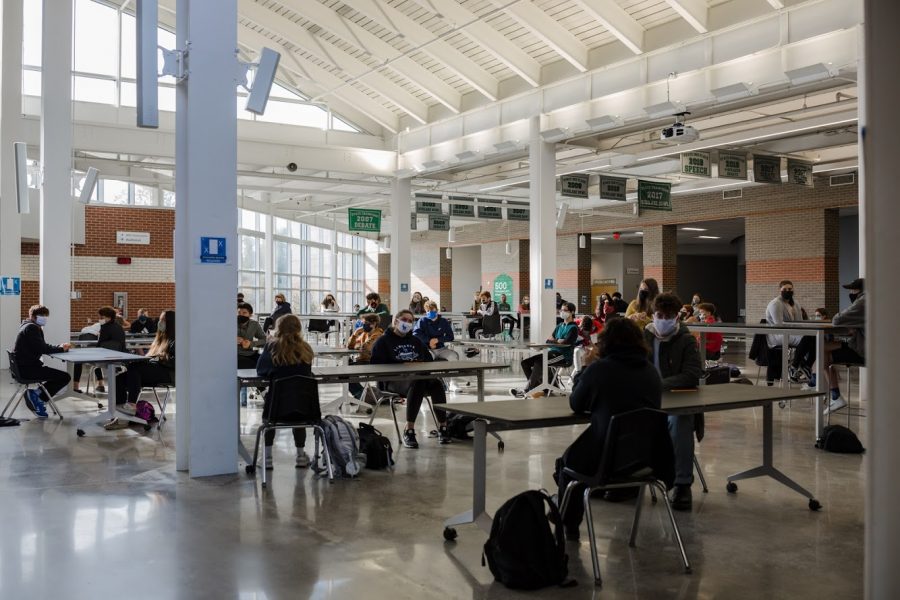Hybrid or Bust
Photo by Elana Ho
December 8, 2020
Everyone was interested to see what developments schools would make to adapt to new safety regulations and also minimize losses to curriculum and the school community. Now, eight months later, Lawrence schools have returned to in-person schooling with various hybrid systems.
While Seabury has been doing in-person school for months, Lawrence public schools opted to do a hybrid learning system with each student attending in-person school once a week. Schools have also gradually decreased the pool of exclusively live learners over the past couple of months. Both systems work to keep students safe while attempting to maintain the quality of education, but not everybody agrees on how well they reach these standards.
Seabury eighth grader Eni Wintoki, for example, feels that online learning is harder. “It is definitely harder to learn while we’re online,” she says. “I just didn’t feel like I was getting anything, and that I was mostly just reading stuff and trying to memorize it.” Although Wintoki appreciates the efforts to keep students safe, she also feels that some factors of Seabury’s system, like the numbered release, could be improved. “It feels nice to be able to walk to class with your friend, but I still feel like there’s a lot of congregation at the doors and our lockers and stuff.”
Free State sophomore Evie Stull feels that her school’s hybrid learning system is greatly inferior to an in-person education. “I definitely feel safe,” she says, but, “I feel like I’m not being checked up on as much. My teachers are less likely to know if I don’t understand things.”
Similarly, Diego Klish, a current junior at Lawrence High and a former member of the Seabury class of 2022 also agrees that he feels “extremely safe,” and thinks the system is “very effective” at preventing transmission. However, he wishes that he could be in person more: “If I could change anything, obviously I would want more hybrid, because I like hybrid. It helps me to focus better.”
Students also struggle with maintaining social relationships in this climate. “It’s harder, I feel, to take initiative to go and see someone, because I can really only talk to people on zoom calls most of the time,” says Wintoki. “In the classroom, since we’re not at one table, I also feel a bit less connected to all the other people in my class . . . But it’s still good to see them everyday since it’s kind of annoying being at your house all the time,” she says.
Even at much larger schools, students are faring no better: “I feel like my social circle is shrinking and I’m losing relationships because I just can’t see and talk to people,” says Stull. Free State and Lawrence High may have several times as many students as Seabury, but Stull says the hybrid learning system still leaves halls empty: “Normally where you’d be rubbing elbows with people in the common spaces, there’s no one. The school is like a ghost town.” Although an empty hallway is definitely safer than a crowded one, it is much lonelier.
Klish also finds the emptiness of classrooms strange, saying, “There’s hardly anyone in my classes because of how they’ve been divided up.” Klish, however, feels like his social life is not being negatively impacted. “I ran cross country; I have friends all on the team now, so it really has not impacted my sports or social life at all,” he says.
Now, for all the things that are less than satisfactory, there are some benefits to hybrid learning systems. “The amount of stress is better, I have a lot less stress,” says Stull. Part of this is due to the decreased workload, but learning from home can also be a less frantic work environment that offers comforts regular school cannot.
Klish also feels that his workload is better with hybrid learning. “Homework is not as bad, because a lot of times you can do homework during class,” he says.
There is a tradeoff with every compromise, and while online and hybrid learning may prevent the spread of Covid-19 on school grounds and decrease homework-related stress, many students feel that they are sacrificing the quality of their education and school community in the process. Obviously, this is a necessary compromise, as students’ health and safety should be everyone’s top priority, but students certainly have a right to be frustrated.
